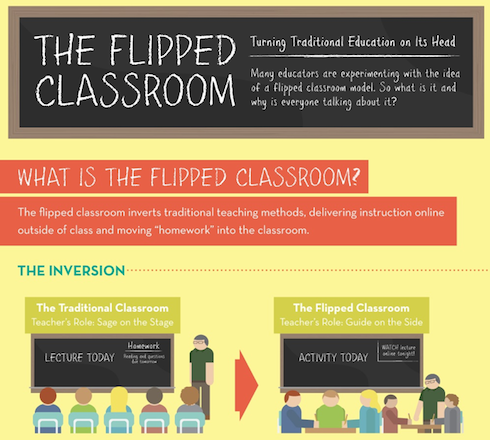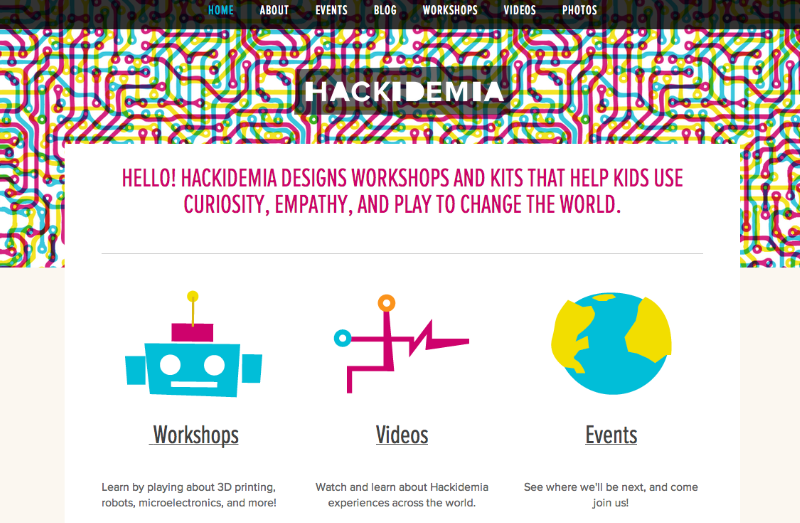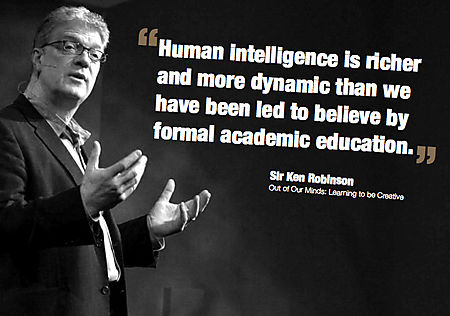The Education Revolution
What is the education revolution and what does technology have to do with it?
It all started with the famous Ken Robinson talk explaining how schools kill creativity. In a few minutes of caustic British humor and explicit drawings, we understood how the current education system has been created to answer the standardized needs of the industrial revolution but can no longer meet the flexibility and diversity needed in today’s work market. Where we once needed obedient uniform soldiers, we are now looking for witty and dynamic individuals. Some even question the relevance of traditional higher education.
How can we prevent students from getting bored? How can we prevent school drop-outs from classes of one-size-fits-all?
And above all, how do we harness the technology to give access to education to the 80% of youth who currently will not have a highschool diploma?
In his book, “The One World School House”, Salman Khan, the Founder of Khan Academy, one of the most famous free online education videos website says: “Technology-enhanced teaching and learning is our best chance for an affordable and equitable educational future.”
The democratization of education is in march.
One of the best examples is Shai Reshef’s University of the People, the world’s first tuition-free online university dedicated to the democratization of higher education.
There is also Coursera, a social entrepreneurship company based in Mountain View, CA. They are partnering with 33 top universities in the world and are proposing to “Take the world’s best courses, online, for free.” The start-up raised $16 million last year to offer the best online education worldwide for free. And we can’t forget Udacity, which also aims at bringing “university-level education to the masses”.
The world’s most prestigious universities have taken advantage of the opportunity to be among the first ones to deliver their renowned curriculum online: Harvard University and the Massachusetts Institute of Technology have partnered together to create EdX, their own interactive online open education courses. Along with offering online courses, these institutions use this opportunity to research how people learn and how technology transforms learning.
Additionally, Stanford is currently offering popular online engineering classes free of charge.
This new wave of MOOCs (Massive Online Open Course) is constantly in the news and journalists are asking “Has the future of college moved online?”
Technology in education
It is certain that technology has offered new perspectives—learning can now move to the home, at each person’s pace, and surely we will all transition from books to tablets in a few years. It not only meets the needs for lifelong learning and constant renewal of skills, but it also lowers the inequalities in access to knowledge, inequalities that are related to geographical or financial background, disabilities, socio-cultural context, age or gender.
Different initiatives have so far leveraged the power of technology to share knowledge:
– Skillshare is a famous global community where you can learn real-world skills from incredible teachers.
– General Assembly transforms thinkers into creators through education and opportunities in technology, business, and design.
– Une minute pour comprendre in France supports students after school.
– Hadithi is an online repository of open access (OA) research for university students, academics and researchers. They build partnerships with OA publishers across the world, obtain their content and then host it on their platform.
Education around the world
In South Africa, CIDA is the first virtually free higher education institution in South Africa, offering holistic education to historically disadvantaged youth who would not otherwise be able to access higher education. And Ikamvayouth equips learners from disadvantaged communities with the knowledge, skills, networks and resources to access tertiary education and/or employment opportunities once they matriculate. The organization’s sustainability is driven by alumni who gain entrance to tertiary institutions and return to tutor.
The whole movement is questioning the standard method of teaching, building a collaborative model where there is no top-down relationship but rather an equalizing horizontal exchange between learners and “knowledge-providers”.
Thus, Thibaut Labarre from Les nouveaux Etudiants describes how involving teachers, students and administrators into dialogues and incorporating alternative technologies can bring change to the education system. They set up Edu’Hack’tions, a workshop between innovative students and teachers who wants to “hack” education and find ways to conceive impassioning, efficient, smart and fun classes.
UniShared, Connecting Learners, is a platform for collaborative and open notes taking. Practically speaking, it leverages Google Docs real-time technology to connect amphitheaters with the rest of the world, in order to improve the way people learn.
Cup of Teach is the first university between individuals, proposing practical, cheap and collective workshops next to your place.
Living School is a private primary and elementary school with the mission to foster, through education and training, the emergence into the world of fulfilled and responsible citizens, actors who will contribute to the veritable evolution of humanity.
At the end of the day, the education revolution is all about customization and adapting to each student’s personal  pace.
pace.
For example, in its model of the flipped classroom, Knewton is delivering instruction online outside the class to dedicate the class time to answer specific questions. This challenges the one-size-fits-all traditional model and the “balkanization” of teaching different subjects in different silos.
And the focus is not only the students but also on the teachers, since technology is not supposed to threaten the teachers, but rather to help them focus on the content and personalize their approach. Many initiatives focus on how to facilitate teaching and share resources.
For example, Fullmarks is a tool to support educators by allowing them to work together, sharing questions and tests, and analyzing results.
Even the TED conference has created the TED-Ed, Lessons worth sharing where any teacher can use engaging videos to create customized lessons. Educators can use, tweak, or completely redo any lesson featured on TED-Ed, or create lessons from scratch based on any video from YouTube. They can turn a video into a customized lesson that can be assigned to students or shared more widely. They can add context, questions and follow-up suggestions.
New Teacher Center (NTC) is partnering with Coursera to offer high-quality online professional learning for K-12 teachers via MOOC. They believe teachers are learners too, and they support new teachers through an online mentoring platform, eMSS.
Guru-G is democratizing education by first democratizing access to quality teachers. It creates a game-based teaching, teacher training, and open certification platform.
This revolution also applies to traditional studies like business schools.
In Denmark, KaosPilot, a ground-breaking global educational model, is dedicated to teaching creative entrepreneurship and social innovation. From its base in Denmark, this school has spent the past twenty years training socially responsible entrepreneurs and agents of change, creative and committed young people seeking to create value, make a difference and shape the society of the future.
In Spain, in the Basque Country, the cooperative Mondragon is offering the MINN Program [International Executive Master Program in Intrapreneurship and Open Innovation]. They call themselves “a lively, constantly evolving executive learning journey at the service of creative processes, participatory and open environments.” Their goals are to research and evaluate the relationships between individuals, modern businesses, and communities. They promote experimentation and cross-discipline education/experiences.
A new model
Traditional teaching techniques are challenged: In this video of Fast CoExist, Seth Godin or the last TED prize Sugata Mitra explain how the current educational system has its origins in the military system creating identical individuals, obedient soldiers and docile customers.
However, education has been moving farther and farther away from this traditional model—students should be creative, have fun while learning, and master critical thinking and analytical skills. Numerous studies are showing that kids learn better when they are playing, as opposed to feeling forced. Because of this, gaming is becoming a much more important part of education.
Dr. Sugata Mitra’s “Hole in the Wall” experiments have shown that, in the absence of supervision or formal teaching, children can teach themselves and each other, if they’re motivated by curiosity and peer interest. In 1999, Mitra and his colleagues dug a hole in a wall bordering an urban slum in New Delhi, installed an Internet-connected PC, and left it there (with a hidden camera filming the area). What they saw was kids from the slum playing around with the computer and in the process learning how to use it and how to go online, and then teaching each other.
The “Hole in the Wall” project demonstrates that, even in the absence of any direct input from a teacher, an environment that stimulates curiosity can cause learning through self-instruction and peer-shared knowledge.
 In the makers community, Hackidemia designs workshops and kits enabling kids to use curiosity, play, and empathy to solve global challenges. All over the world, they organize workshops fostering collaboration between schools, tech companies and kids in the development of 3D-enabled curricula, tools, and learning environments for the 21st century learner.
In the makers community, Hackidemia designs workshops and kits enabling kids to use curiosity, play, and empathy to solve global challenges. All over the world, they organize workshops fostering collaboration between schools, tech companies and kids in the development of 3D-enabled curricula, tools, and learning environments for the 21st century learner.
Three Coins uses social online gaming for training financial literacy skills and was awarded Coca Cola’s “Ideas against Poverty” prize.
And Medialab in Madrid organizes a urban camp of active, experimental and learning space for kids during the mornings: A big laboratory where you can make your own robot, design and build your musical instrument, a radio or even play with food and discover how math is not just numbers. Throughout the day kids participate and discover some of the newest technologies developed by Medialab-Prado’s work groups: 3D printing, electronics applied to almost everything or food reuse to learn not to throw food away.
Each year, different forums focus on the new trends on how to revolutionize the field of education:
The World Innovation Summit for Education (WISE) is dedicated to building the future of education through innovation. This annual three-day event in Doha, Qatar, brings together over 1,000 top decision-makers, thought-leaders, practitioners and education stakeholders from a wide variety of sectors and more than 100 countries to seek innovative solutions to today’s educational challenges and to share best practices.
The world is changing and the way we learn as well. How will this affect the traditional education system is still a mystery. But all these innovations are aiming at a greater access to knowledge for all.



